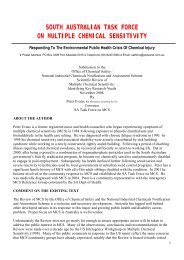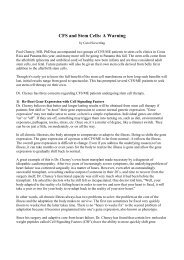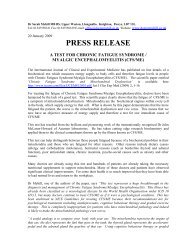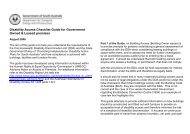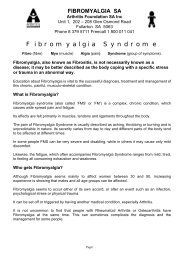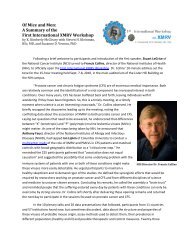72 L. Altomonte et al.In a clinical setting special attention should be paidto previous pain episodes, pain reports from variouslocations on the body, tender points, distress,somatisation, fatigue, and sleep disturbances. Presenceof these symptoms may predict developmentof chronic pain (8, 9).The development and persistence of chronic musculoskeletalpain may also be predicted by severalsocio-demographic, lifestyle and psychosocial riskfactors.Family history of chronic pain, low educationallevel, low socioeconomic group and lack of socialsupport are other common risk factors.Some ethic groups and immigrants have also beenshown to have an increased risk for developmentof chronic pain (11).Smoking, sedentary lifestyle and obesity are predictivefactors that could be targets for intervention(12).A number of stressors have been temporally correlatedwith the onset of the syndrome, includingtrauma, infection (e.g., hepatitis C virus, HIV, Lymedisease), emotional stress, catastrophic events(e.g., war), autoimmune diseases and other painconditions (13, 14).In conclusion, the goal of secondary prevention isto facilitate early detection of disease developmentwhen patients are asymptomatic and interventionimproves outcome. Early detection methods forFM patients include analysis of tender points, FibromyalgiaImpact Questionnaire (FIQ), pain locationand intensity, fatigue and sleep complaints(15, 16).Tertiary prevention of fibromyalgiaTertiary prevention inhibits further deterioration orreduces complications after the disease has declareditself. In FM the aim of treatment is to managesymptoms, specifically, to decrease pain and increasefunction, via multimodal therapeutic strategies,which, in most cases, include pharmacologicaland non-pharmacological interventions (17,18). As FM patients typically present with complexsymptoms and co-morbid conditions, they cannotbe managed realistically by primary care providers,alone, but require the assistance of multidisciplinaryteams with expertise in a variety of physical,cognitive, behavioural and educational strategies(17).In conclusion, prevention strategies for FM may beof paramount importance. In fact, since no cure iscurrently available, primary and secondary preventionstrategies may greatly reduce the prevalenceof this syndrome. Tertiary prevention will enablepatients to implement therapeutic approachesas early as possible, to monitor the results and toprevent the secondary effects of chronic widespreadpain and the ancillary symptoms.The economic impact of fibromyalgiaFew studies have analyzed the economic impact ofFM in terms of costs of disease and pharmacoeconomicbalance.A literature search using keywords “Fibromyalgia”and “Costs and Cost Analysis” identified only 51publications; of these, only 9 addressed pharmacoeconomicaspects (19-27) and 8 addressed diseasecosts both as direct costs, i.e., charged to publichealth systems and to patients for diagnosis andmedical assistance, and as indirect costs, i.e., financialconsequences of reduced productivity by illpatients (28-35). No publications analyzed the costor consequence of reduced quality of life for patients.Over the last decade, the annual direct costs of FMhave increased considerably. Today, these costsrange between 4.500 and 7.500€ per patient (28-35). The variability in this range is due to differentmethods being used to evaluate costs in differentyears and in different socio-economic conditions ofFM patients. The same study, however, concludesthat the most important determinant of costs are comorbidities,subjective and objective health state,emotional state and social conditions of the patient(21, 24, 28).Health costs comprise about 1/3 of direct costs, aproportion that is accompanied by several causesfor concern. First, the cost of admission to the hospitalfor diagnosis can have a significant impact onoverall costs due to the complexity of the clinicalsymptoms.Second, therapy can be quite expensive given theoverall poor response to treatment among manypatients (31, 32, 35). The lack of validated therapeuticprotocols may explain the frequent use ofphysiotherapy or alternative therapy without a correspondingincrease in costs for the public healthsystem (26).Social support, whether support groups or personalnetworks, and education programs are inexpensiveand useful avenues for facilitating psychologicalwell being and optimizing available health resources(23).The indirect costs of FM range between 2.000 to7.000 € per patient per year. Only one of threeeconomic studies in our search indicated that the
Fibromyalgia syndrome: preventive, social and economic aspects 73indirect costs of FM were higher than the directcosts, as is generally the case for other rheumaticdiseases (31, 32, 35).If the body of literature for disease costs seems insufficientfor FM, the pharmacoeconomic literatureis even more inadequate. The majority of thesestudies have described the methodology of investigationrather than analysed the specific expenses(19-25). Conclusions are not definitive and it is notpossible to define the best investment. The justificationfor this is that well-defined indicators forevaluating achievement of predetermined goals orvalidated therapeutic protocols were not available.Further, improvements from a specific therapywere too short-lived to draw meaningful conclusions(23, 26, 27).Disability and employment in FM patientsIt is difficult to assess disability and employmentin FM patients, given the limited data in the scientificliterature. Every social assessment is closelyrelated to the socio-economic level of the generalpopulation and to the legislation of the country inwhich the FM patient lives.In clinical investigations, FM is well known andstudied; the case worker, however, is accustomedto evaluating laboratory and physical data objectivelyand may have reasonable doubts in evaluatingthe FM patient for insurance purposes and abilityto work.Therefore, it is understandable that there may befundamental differences in the assessment of disabilityand employment between Italy and othercountries, just as it is understandable that there maybe differences between the clinical and medical-legalevaluation of FM patients.Several difficult issues cloud the ability to estimatethe effect of FM in Italy with accuracy. The first issueis the fundamental recognition of disease: IsFM universally recognized by physicians or is itidentified with other diseases? How many diagnosesof osteoarthtritis (OA) or how many depressivesyndromes or cases of “early arthritis” overlapwith FM in clinical practice?The second issue is the comparison of statistical data.In Italy, it is difficult to compare data from centralizeddatabases that are involved in different aspectsof public health: ISTAT (Central Statistic Institute)(36), Ministry of Health, INPS (National Instituteof Social Insurance) (37), INAIL (NationalBoard for the Insurance against Accidents in IndustrialWork, responsible for occupational diseases)(38).The ISTAT manages data from sample surveys regardingthe influence of chronic diseases; and itsuggested the atypical classification of “osteoarth -ritis-arthritis” that combines diseases which aresubstantially different. FM has no place in this classificationdespite its significant incidence amongrheumatic diseases and chronic diseases. This incidenceof FM has been reported in Italian clinicalstudies and has been confirmed in the internationalscientific literature.INPS and INAIL do not include FM in their statisticaldata concerning the granting of partial andtotal disability as paid by the two larger Italian publicinsurance institutes.In 1980, the International Classification of Impairments(ICF), Disability and Health (ICDH) includeddistinctions between impairment, disabilityand handicap. In 20<strong>01</strong>, a new International Classificationof Functioning (ICF), Disability andHealth was officially endorsed by 191 WorldHealth Organization Member States during the54th World Health Assembly as “the internationalstandard to describe and measure health and disability”(38). The general aim of ICF is to developa common metric system to describe and measureindividual health conditions and contextual factors,which are described by physical, individual, andsocial perspectives and divided into Functions,Bodily Structures, Participation and Activity. Furthermore,the classification accounts for the environmentalfactors that can impact the individual’slife and interact to determine disability, and it is definedas the consequence or the result of a complexrelationship between the health conditions, personalfactors and environmental factors representingthe circumstances where the individual lives.ICF does not simply view disability only as a “medical”or “biological” dysfunction; rather, it providesa mechanism to document the impact of the socialand physical environment on a person’s functioning.The clinical evaluation of disability involves specificassessments such as the FIQ (40), which hasbeen validated in Italy (15). Nevertheless, it is difficultto apply this and other evaluations in legalmedicine, especially if they do not refer to laboratorydata. Then the claim of disability can lead toadditional difficulty for the FM patient if she experiencesnegative feedback from official Institutionsthat may not recognize the illness.Aside from chronic pain, the FM patient may complainof various, specific symptoms that may reducework performance of the subject. For exam-
- Page 2 and 3:
2 P. Sarzi-Puttini et al.The meetin
- Page 4 and 5:
4 M. Cazzola et al.(2). In the earl
- Page 6 and 7:
6 M. Cazzola et al.enough to meet F
- Page 8 and 9:
8 M. Cazzola et al.Table I - Charac
- Page 10 and 11:
10 M. Cazzola et al.Table IV - Cond
- Page 12 and 13:
12 M. Cazzola et al.teria, three su
- Page 14 and 15:
14 M. Cazzola et al.tients with a n
- Page 16 and 17:
16 G. Cassisi et al.The cardinal fe
- Page 18 and 19:
18 G. Cassisi et al.StiffnessIn FM
- Page 20 and 21:
20 G. Cassisi et al.Autonomic and n
- Page 22 and 23: 22 G. Cassisi et al.Associated symp
- Page 24 and 25: 24 G. Cassisi et al.46. Coleman RM,
- Page 26 and 27: 26 S. Stisi et al.sensitization,”
- Page 28 and 29: 28 S. Stisi et al.Sum oflife-events
- Page 30 and 31: 30 S. Stisi et al.trols, they prese
- Page 32 and 33: 32 S. Stisi et al.stress, obtained,
- Page 34 and 35: 34 S. Stisi et al.50. Harris RE, Cl
- Page 36 and 37: ORIGINAL ARTICLEReumatismo, 2008; 6
- Page 38 and 39: 38 F. Atzeni et al.lalanine (17), a
- Page 40 and 41: 40 F. Atzeni et al.clearer and it m
- Page 42 and 43: 42 F. Atzeni et al.healthy control
- Page 44 and 45: 44 F. Atzeni et al.and/or verbal (e
- Page 46 and 47: 46 F. Atzeni et al.for study purpos
- Page 48 and 49: 48 F. Atzeni et al.mimics of fibrom
- Page 50 and 51: ORIGINAL ARTICLEReumatismo, 2008; 6
- Page 52 and 53: 52 P. Sarzi-Puttini et al.A larger
- Page 54 and 55: 54 P. Sarzi-Puttini et al.from 1966
- Page 56 and 57: 56 P. Sarzi-Puttini et al.rational,
- Page 58 and 59: 58 P. Sarzi-Puttini et al.49. Toffe
- Page 60 and 61: 60 R. Casale et al.cal exercise and
- Page 62 and 63: 62 R. Casale et al.definition of
- Page 64 and 65: 64 R. Casale et al.are more or less
- Page 66 and 67: 66 R. Casale et al.trol associated
- Page 68 and 69: 68 R. Casale et al.32. Lewit K. The
- Page 70 and 71: ORIGINAL ARTICLEReumatismo, 2008; 6
- Page 74 and 75: 74 L. Altomonte et al.Table II - We
- Page 76 and 77: 76 L. Altomonte et al.treatments de



